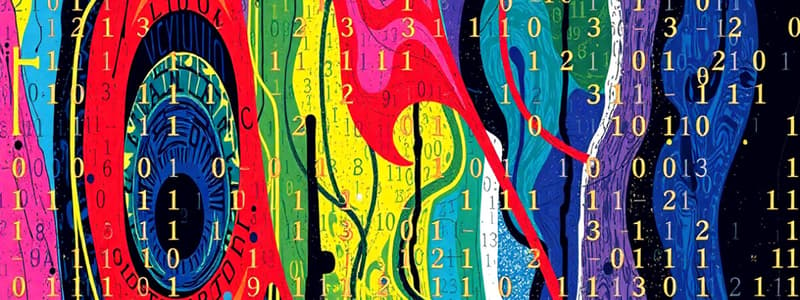Podcast
Questions and Answers
Who invented stream ciphers in 1917?
Who invented stream ciphers in 1917?
- Christof Paar
- Gilbert Vernam (correct)
- Thomas Eisenbarth
- Jan Pelzl
Which of the following is NOT a topic covered in Chapter 2?
Which of the following is NOT a topic covered in Chapter 2?
- One-Time Pad (OTP)
- Linear feedback shift registers (LFSRs)
- Block ciphers (correct)
- Random number generators (RNGs)
What is the role of Linear Feedback Shift Registers (LFSRs) in stream ciphers?
What is the role of Linear Feedback Shift Registers (LFSRs) in stream ciphers?
- To provide asymmetric encryption
- To construct hash functions
- To facilitate block-wise encryption
- To generate pseudo-random sequences (correct)
Which of the following statements about stream ciphers is true?
Which of the following statements about stream ciphers is true?
What additional topic is included in the content regarding modern stream ciphers?
What additional topic is included in the content regarding modern stream ciphers?
What is a primary characteristic of stream ciphers?
What is a primary characteristic of stream ciphers?
What does the operation 'yi = xi + si mod 2' represent in stream ciphers?
What does the operation 'yi = xi + si mod 2' represent in stream ciphers?
In synchronous stream ciphers, what does the key stream depend upon?
In synchronous stream ciphers, what does the key stream depend upon?
Why is it important for the key stream in a stream cipher to be random?
Why is it important for the key stream in a stream cipher to be random?
What is the main difference between synchronous and asynchronous stream ciphers?
What is the main difference between synchronous and asynchronous stream ciphers?
What is the main characteristic of a Cryptographically Secure Pseudorandom Number Generator (CSPRNG)?
What is the main characteristic of a Cryptographically Secure Pseudorandom Number Generator (CSPRNG)?
Which property makes the One-Time Pad (OTP) an unconditionally secure cryptosystem?
Which property makes the One-Time Pad (OTP) an unconditionally secure cryptosystem?
In a simple PRNG, what does the formula Si+1 = A * Si + B mod m represent?
In a simple PRNG, what does the formula Si+1 = A * Si + B mod m represent?
Which of the following is a necessary condition for a linear congruential generator to be secure?
Which of the following is a necessary condition for a linear congruential generator to be secure?
What is typically the main application for CSPRNGs in cryptography?
What is typically the main application for CSPRNGs in cryptography?
What happens when one uses the same key multiple times in a One-Time Pad?
What happens when one uses the same key multiple times in a One-Time Pad?
Why are most simple PRNGs considered to have bad cryptographic properties?
Why are most simple PRNGs considered to have bad cryptographic properties?
Which of the following components are essential for encrypting with an OTP?
Which of the following components are essential for encrypting with an OTP?
What operation is equivalent to modulo 2 addition in the context of stream ciphers?
What operation is equivalent to modulo 2 addition in the context of stream ciphers?
What is the key length and throughput of the AES symmetric cipher?
What is the key length and throughput of the AES symmetric cipher?
What is a characteristic of True Random Number Generators (TRNGs)?
What is a characteristic of True Random Number Generators (TRNGs)?
Which of the following describes a Pseudorandom Number Generator (PRNG)?
Which of the following describes a Pseudorandom Number Generator (PRNG)?
What is the primary purpose of a good random number generator in cryptography?
What is the primary purpose of a good random number generator in cryptography?
What statistical property should the output stream of a true RNG ideally have?
What statistical property should the output stream of a true RNG ideally have?
Which stream cipher has the highest throughput according to the performance comparison?
Which stream cipher has the highest throughput according to the performance comparison?
What occurs during the XOR operation when both input bits are 1?
What occurs during the XOR operation when both input bits are 1?
What is a significant drawback of most Pseudorandom Number Generators (PRNGs)?
What is a significant drawback of most Pseudorandom Number Generators (PRNGs)?
What is a key disadvantage of the One-Time Pad (OTP) cryptosystem?
What is a key disadvantage of the One-Time Pad (OTP) cryptosystem?
What does an LFSR consist of?
What does an LFSR consist of?
Which equation describes the output of a linear feedback shift register?
Which equation describes the output of a linear feedback shift register?
What is the maximum output length of an LFSR with degree m?
What is the maximum output length of an LFSR with degree m?
What is required for the One-Time Pad to be unconditionally secure?
What is required for the One-Time Pad to be unconditionally secure?
What happens to the output sequence of an LFSR?
What happens to the output sequence of an LFSR?
Which of the following is an example of a modern stream cipher mentioned?
Which of the following is an example of a modern stream cipher mentioned?
What is a necessary condition for the equations in the One-Time Pad to hold true?
What is a necessary condition for the equations in the One-Time Pad to hold true?
What is a key characteristic of LFSRs when m output bits are known?
What is a key characteristic of LFSRs when m output bits are known?
Which statement is true about stream ciphers compared to block ciphers?
Which statement is true about stream ciphers compared to block ciphers?
What type of LFSRs does the Trivium stream cipher utilize?
What type of LFSRs does the Trivium stream cipher utilize?
What is one benefit of stream ciphers in constrained environments?
What is one benefit of stream ciphers in constrained environments?
What is the total register count for the Trivium cipher?
What is the total register count for the Trivium cipher?
Which component is NOT used in the Trivium cipher's output generation?
Which component is NOT used in the Trivium cipher's output generation?
Why are stream ciphers sometimes chosen over block ciphers for certain applications?
Why are stream ciphers sometimes chosen over block ciphers for certain applications?
Which stream cipher is mentioned as an exception to the popularity of block ciphers?
Which stream cipher is mentioned as an exception to the popularity of block ciphers?
Flashcards
Stream Cipher
Stream Cipher
A type of encryption that encrypts data one bit or byte at a time, using a keystream that is generated from a secret key.
Random Number Generator (RNG)
Random Number Generator (RNG)
A device or algorithm that generates a sequence of seemingly random numbers. These numbers are used as keystream for encryption.
One-Time Pad (OTP)
One-Time Pad (OTP)
The most secure encryption method, using a truly random keystream of the same length as the message. Every character is uniquely encrypted.
Linear Feedback Shift Register (LFSR)
Linear Feedback Shift Register (LFSR)
Signup and view all the flashcards
Trivium
Trivium
Signup and view all the flashcards
Block Cipher
Block Cipher
Signup and view all the flashcards
Key Stream (in Stream Ciphers)
Key Stream (in Stream Ciphers)
Signup and view all the flashcards
Synchronous Stream Cipher
Synchronous Stream Cipher
Signup and view all the flashcards
Asynchronous Stream Cipher
Asynchronous Stream Cipher
Signup and view all the flashcards
Unconditionally Secure
Unconditionally Secure
Signup and view all the flashcards
Cryptographically Secure Pseudorandom Number Generator (CSPRNG)
Cryptographically Secure Pseudorandom Number Generator (CSPRNG)
Signup and view all the flashcards
Linear Congruential Generator (LCG)
Linear Congruential Generator (LCG)
Signup and view all the flashcards
Stream Cipher Throughput
Stream Cipher Throughput
Signup and view all the flashcards
Modulo 2 Addition
Modulo 2 Addition
Signup and view all the flashcards
XOR Operation
XOR Operation
Signup and view all the flashcards
True Random Number Generator (TRNG)
True Random Number Generator (TRNG)
Signup and view all the flashcards
Pseudorandom Number Generator (PRNG)
Pseudorandom Number Generator (PRNG)
Signup and view all the flashcards
Keystream
Keystream
Signup and view all the flashcards
Initialization Vector (IV)
Initialization Vector (IV)
Signup and view all the flashcards
LFSR Degree
LFSR Degree
Signup and view all the flashcards
LFSR Maximum Output Length
LFSR Maximum Output Length
Signup and view all the flashcards
Importance of Keystream Randomness
Importance of Keystream Randomness
Signup and view all the flashcards
Study Notes
Course Information
- Course Title: Cryptography
- Course Code: CCY6322-3
- Instructor: Dr. Mohammad Zunnun Khan
- Email: [email protected]
- Year: 2024
Stream Ciphers
- Stream ciphers encrypt data bit by bit, often used in small, fast devices like GSM phones
- Invented in 1917 by Gilbert Vernam
- Contrast with block ciphers, which encrypt blocks of data
- Encryption and decryption using XOR (modulo 2 addition)
- Encryption formula: yi = esi(xi) = xi + si mod 2
- Decryption formula: xi = esi(yi) = yi + si mod 2
- Plaintext (xi), ciphertext (yi), and key stream (si) consist of bits
- Synchronous stream ciphers depend only on the key (and potentially an initialization vector)
- Asynchronous stream ciphers also depend on the ciphertext
Stream Ciphers - Random Number Generators (RNGs)
- RNGs generate the key stream for encryption, critical for stream ciphers' security
- Cryptographically secure RNGs are essential in cryptography
- True RNGs are based on physical phenomena, like radioactive decay
- Pseudorandom number generators (PRNGs) generate a pseudo-random sequence based on a seed value
- PRNGs have statistical properties, but are predictable
Stream Ciphers - Linear Feedback Shift Registers (LFSRs)
- LFSRs are a type of PRNG used in stream ciphers
- Consists of flip-flops that generate a pseudo-random sequence using a feedback equation
- Maximum output length is (2^m)-1, where m is the degree of the feedback equation
Stream Ciphers - One-Time Pad (OTP)
- Unconditionally secure; no computational method can break it
- The key must be as long as the message to ensure perfect security, which is impractical
- OTP encryption: eki(xi) = xi ⊕ ki
- OTP decryption: dki(yi) = yi ⊕ ki
Stream Ciphers - Trivium
- A modern stream cipher
- Combines techniques from various stream cipher forms
- Often utilizes LFSRs in its implementation pattern
Studying That Suits You
Use AI to generate personalized quizzes and flashcards to suit your learning preferences.




